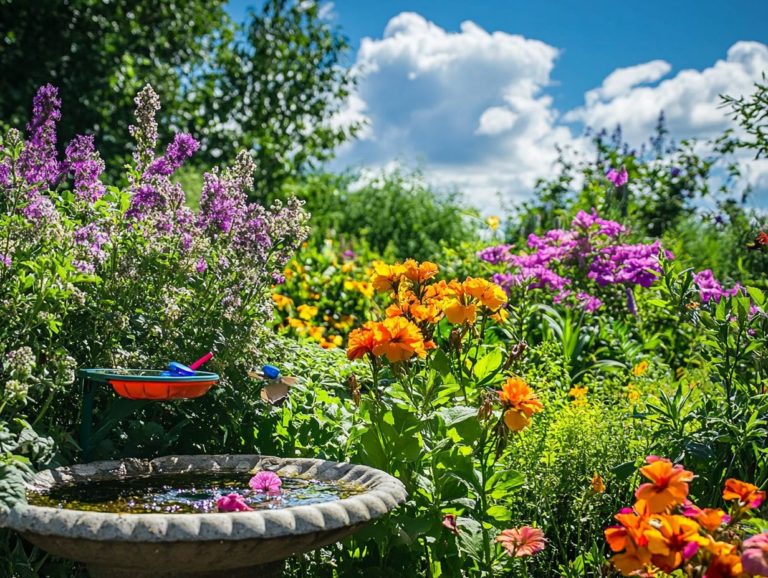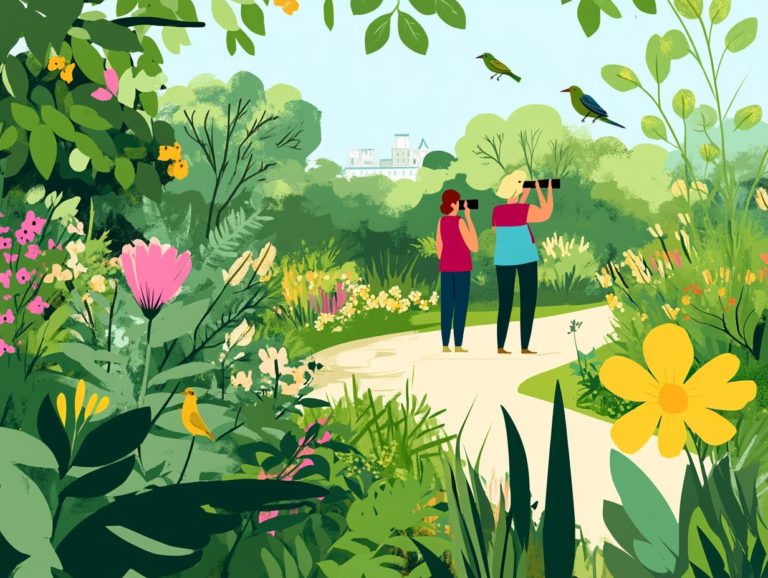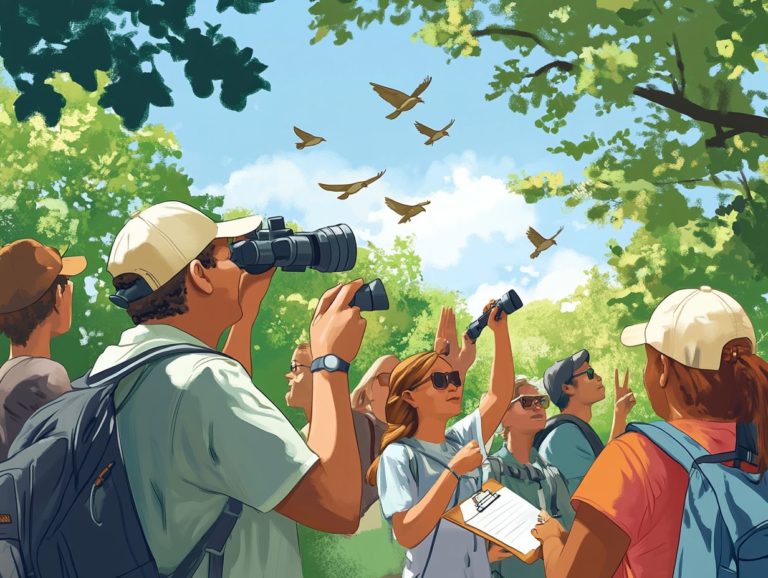7 Tips for Bird Watching in Urban Areas
Bird watching in urban areas can be a surprisingly rewarding experience, providing a unique blend of nature and city life. Whether you are a seasoned enthusiast or a curious beginner, understanding best practices can enhance your birding adventures.
This article presents seven essential tips to help you maximize your observations, from selecting the right time of day to joining a local birdwatching club. Explore the benefits of birdwatching in cities, discover common birds, and learn how to attract them to your backyard.
Contents
- Key Takeaways:
- 1. Choose the Right Time of Day
- 2. Look for Green Spaces
- 3. Use Binoculars
- 4. Listen for Bird Calls
- 5. Be Patient and Observant
- 6. Bring a Field Guide
- 7. Join a Local Bird Watching Group
- What Are the Benefits of Bird Watching in Urban Areas?
- What Are the Most Common Birds Found in Urban Areas?
- How Can One Attract Birds to Their Urban Backyard and Support Bird Migration?
- What Safety Precautions Should Be Taken When Bird Watching in Urban Areas?
- How Can One Contribute to Bird Conservation in Urban Areas?
- What Are Some Common Mistakes to Avoid When Birdwatching in Urban Areas?
- Frequently Asked Questions
- What Are the Benefits of Birdwatching in Urban Areas?
- How Can I Find Good Birdwatching Spots in Urban Areas?
- What Time of Day Is Best for Birdwatching in Urban Areas?
- How Can I Attract Birds to My Own Urban Backyard?
- What Should I Bring with Me When Birdwatching in Urban Areas?
- What Should I Do If I Encounter a Sick or Injured Bird While Birdwatching in Urban Areas?
Key Takeaways:
- Visit urban parks early in the morning or late afternoon for the best birdwatching experiences!
- Bring binoculars and a bird guide to aid in bird identification.
- Joining a local bird watching group can provide valuable knowledge and companionship while exploring urban areas.
1. Choose the Right Time of Day
Birding is most rewarding during the early morning or late afternoon, as these times typically offer the best opportunities to spot a variety of bird species in both urban and natural birdwatching locations, such as Central Park and Jamaica Bay in New York City.
Birds are generally more active during the cooler hours of the day and tend to be most visible at dawn and dusk, regardless of the season. In spring, many migratory species, including warblers and thrushes, can be easily observed in the early morning light. During the summer, the evening light often reveals herons and other waterfowl.
Birders should visit known birdwatching hotspots around sunrise or just before sunset, while also considering light conditions. The softer light during these times can help minimize harsh shadows, making it easier to appreciate the finer details of bird feathers and bird behavior.
2. Look for Green Spaces
Discovering green spaces, such as parks and wildlife sanctuaries, is a thrilling adventure for birdwatchers. These areas provide vital habitats for diverse bird species and enhance the overall experience of nature appreciation in urban environments like New York City.
One notable example is Tommy Thompson Park, a hidden gem that features expansive wetlands and lush landscapes, attracting migratory birds throughout the year. Inwood Hill Park, with its dense forests and winding trails, offers a peaceful retreat where visitors can spot everything from warblers to egrets.
These green havens not only play a crucial role in sustaining local ecosystems but also serve as sanctuaries for numerous species, with their dense vegetation providing nesting sites and food. As city dwellers seek respite from concrete surroundings, these parks stand as vibrant oases that foster both biodiversity and community connection.
3. Use Binoculars
The right binoculars significantly enhance birdwatching by enabling birders to better identify various bird species, whether using basic binoculars for sufficient detail or opting for spotting scopes for clear views of distant wildlife.
With a wide range of features available, there are binoculars suited for every skill level and need. For casual birdwatchers, compact binoculars with an 8×42 configuration offer a good balance between magnification and brightness. In contrast, more dedicated birders might prefer high-powered options with 10×50 lenses for greater detail.
Waterproof and fog-proof designs are essential for those in extreme climates, while technology that reduces shaking can greatly enhance the experience by improving clarity. Ultimately, birders should consider their typical environments and the types of birds they intend to observe when selecting the binoculars that are best for them.
4. Listen for Bird Calls
Listening for bird calls is a vital technique in birding. Each bird produces a unique sound that can indicate its presence long before it becomes visible. Recognizing these calls enhances your enjoyment of birdwatching, especially in urban environments where visual cues may be harder to discern.
By tuning into these audio signals, birders can identify species that might otherwise remain unnoticed amidst the hustle and bustle of city life. Resources such as online libraries of bird calls, mobile apps, and community workshops are valuable tools for enthusiasts looking to improve their listening skills.
Technology, like sound recognition software that can identify bird calls for you, can bridge the gap between novice and experienced birders. This makes it easier to distinguish the subtle yet species-specific variations in calls.
5. Be Patient and Observant
Patience and awareness are essential qualities for successful birdwatching. Many species can be challenging to detect and often require a still and observant approach to locate them. This practice of stillness involves tuning your senses and appreciating the subtleties of your surroundings.
Find a quiet, comfortable spot in nature where you can sit and allow the sights and sounds to envelop you. Respect for wildlife is another crucial aspect of ethical birdwatching. Maintaining a safe distance from nests and avoiding disruptive behaviors helps these animals thrive.
The joy of birdwatching comes from observing birds in their natural habitats, not just spotting rare species. It’s about appreciating the interactions and behaviors of birds in the wild.
6. Bring a Field Guide
A bird guide is an essential accessory for birdwatchers. It helps you accurately identify the birds you encounter during your birdwatching trips, enhancing both the enjoyment and educational aspects of the activity.
Field guides come in various forms, from traditional books to interactive digital applications accessible on smartphones and tablets. Using these resources effectively requires understanding the guide’s structure and knowing where and when to look for specific birds.
For birders in urban settings like New York City, the Peterson Field Guide to Birds of Eastern and Central North America and Birds of New York are valuable resources. Similarly, birders in Kingston will find Birds of Southern Ontario especially helpful.
7. Join a Local Bird Watching Group
Joining a local birdwatching community will transform your birding experience into an adventure! These groups enhance your experience through social activity, shared knowledge, and organized birdwatching events that foster community among bird enthusiasts.
They often provide a welcoming environment where individuals connect with fellow bird lovers, exchange tips on identifying various species, and participate in group trips that may lead to encounters with rare birds in their region.
In urban settings, organizations like the NYC Audubon Society and the San Francisco Birding Club offer workshops, guided walks, and citizen science opportunities, which involve regular people helping with scientific research. These activities build friendships and keep birding enthusiasts informed about the latest in conservation and birding practices.
What Are the Benefits of Bird Watching in Urban Areas?
The advantages of bird watching in urban areas include helping people appreciate nature among city dwellers. It also improves mental health and promotes wildlife conservation by fostering a better understanding of urban bird diversity, avian ecosystems—the environments where birds live and interact with other species—and interspecies interdependence.
Incorporating birdwatching into daily life provides a calming respite from everyday anxieties. It encourages individuals to connect with their communities. As people gather to admire various bird species, they strengthen social bonds and foster a sense of belonging and shared purpose.
Urban birdwatching is a fun way to learn about the amazing birds around you! It allows individuals to discover their local ecosystems and the vital roles that different avian species play within them. By recognizing that urban environments can support diverse bird populations, people naturally cultivate an interest in protecting these birds and their habitats, which contributes to wildlife conservation efforts.
What Are the Most Common Birds Found in Urban Areas?
Common birds found in urban areas, such as pigeons, sparrows, and ospreys, can be enjoyed by birdwatchers of all skill levels. Among these, the American robin is the most recognizable urban bird.
With its bright red breast and cheerful song, it is easily spotted as it hops around parks and gardens in search of worms. The elusive house finch, characterized by its streaked body and the red or orange plumage of males, tends to favor feeders and rooftops.
Observers can often spot these and other birds in city parks, near lakes and streams, or in suburban and rural areas. Using field guides or smartphone apps enhances the birdwatching experience by providing fascinating details about the species.
How Can One Attract Birds to Their Urban Backyard and Support Bird Migration?
Attracting birds to your urban backyard can be achieved by enhancing its aesthetics and functionality. Use native plants, bird feeders, and water features that support bird habitats and boost local biodiversity. Thoughtfully selecting these elements makes your outdoor space more appealing while accommodating the specific needs of various bird species.
Start with native plants that offer essential food sources, such as berries and seeds, while also providing shelter. Choose feeders that cater to different diets, such as nectar for hummingbirds or seeds for finches. Ensure the types of seeds are suitable for the local bird population. Incorporate a small water feature, like a birdbath or fountain, which provides birds with hydration options and helps attract them year-round.
By balancing beauty and functionality, you can create a peaceful yet vibrant environment that birds will want to call home.
What Safety Precautions Should Be Taken When Bird Watching in Urban Areas?
When birdwatching in urban areas, ensure safety by being aware of your surroundings, respecting the natural behaviors of urban wildlife, and following birding ethics and ethical guidelines.
Awareness of Surroundings: The heavy traffic and presence of pedestrians in urban areas can pose hazards for both birds and observers. It is essential for observers to remain mindful of their surroundings to avoid putting themselves or the birds in danger.
Respect for Wildlife: Many birds and other animals in urban settings may already be stressed due to their environment. Loud noises or intrusions into their territory can force them to leave their nests or alter their natural behaviors, such as feeding.
Following Local Regulations: Most urban areas have designated birdwatching locations and rules regarding feeding wildlife or creating excessive noise. Adhering to these regulations fosters ethical birdwatching practices.
Protecting birds is crucial—every small action counts! Ethical birdwatching is particularly vital in urban environments, where birds may experience heightened stress due to their surroundings, necessitating greater care to help preserve their habitat.
How Can One Contribute to Bird Conservation in Urban Areas?
Individuals can support bird conservation in urban areas by joining local conservation groups, raising awareness about urban bird species, and practicing responsible birdwatching.
By participating in local wildlife organizations focused on preserving bird habitats, individuals can volunteer their time and efforts. Gardening with native plants enhances biodiversity in local environments, providing essential food and shelter for birds.
Citizen science projects offer opportunities for people to contribute data on local bird populations, helping you feel closer to nature while assisting researchers in understanding bird patterns.
Residents can collaborate to pool their resources and knowledge, creating more favorable spaces for birds to thrive in urban settings.
What Are Some Common Mistakes to Avoid When Birdwatching in Urban Areas?
Common mistakes made by birdwatchers in urban areas include a lack of awareness regarding local laws, approaching wildlife too closely, and using inadequate identification tools such as binoculars or bird guides. All of these can diminish the overall birdwatching experience.
Overlooking potential birdwatching locations can lead to missed opportunities, while observing at the wrong time of day may result in minimal activity. New birdwatchers should take time to familiarize themselves with urban parks, green spaces, and bodies of water, as these areas often attract a diverse array of birds.
Seasoned birdwatchers may sometimes forget the importance of being patient and quiet, as excessive noise can scare birds away. Using quality binoculars and field guides specific to their local area can enhance their experience and deepen their appreciation for their avian counterparts.
Frequently Asked Questions
What Are the Benefits of Birdwatching in Urban Areas?
Birdwatching in urban areas allows individuals to connect with nature and observe a diverse range of bird species in their natural habitats. It also promotes physical activity and can be a relaxing and enjoyable hobby.
How Can I Find Good Birdwatching Spots in Urban Areas?
Researching local parks, nature preserves, and green spaces is a great way to find good birdwatching spots in urban areas. Joining local birdwatching clubs or groups can also provide valuable information and tips.
What Time of Day Is Best for Birdwatching in Urban Areas?
The early morning hours are generally the best time for birdwatching in urban areas. This is when birds are most active and vocal, making them easier to spot and identify.
How Can I Attract Birds to My Own Urban Backyard?
Planting native flowers, shrubs, and trees in your backyard can attract a variety of birds. You can also attract birds by providing bird feeders and clean water sources.
What Should I Bring with Me When Birdwatching in Urban Areas?
- Binoculars
- A field guide
- A notebook and pen
- Water
- Appropriate clothing and footwear for the weather and terrain
What Should I Do If I Encounter a Sick or Injured Bird While Birdwatching in Urban Areas?
If you encounter a sick or injured bird while birdwatching in urban areas, do not attempt to handle or feed it. Instead, contact a local wildlife rehabilitator or animal control for assistance.



